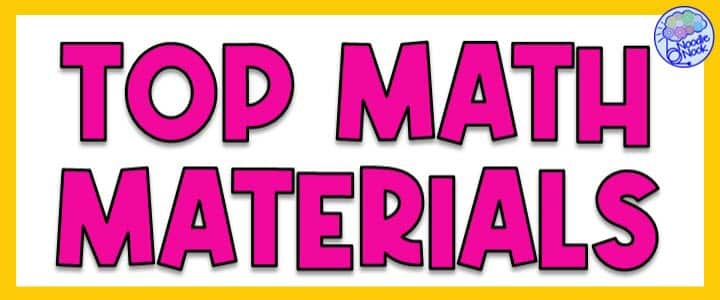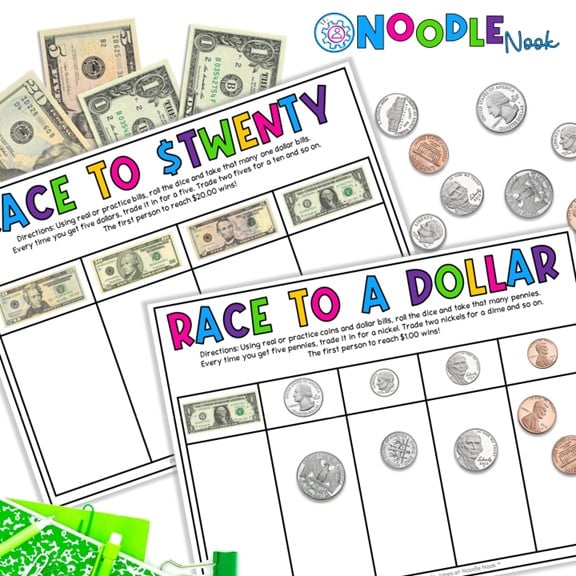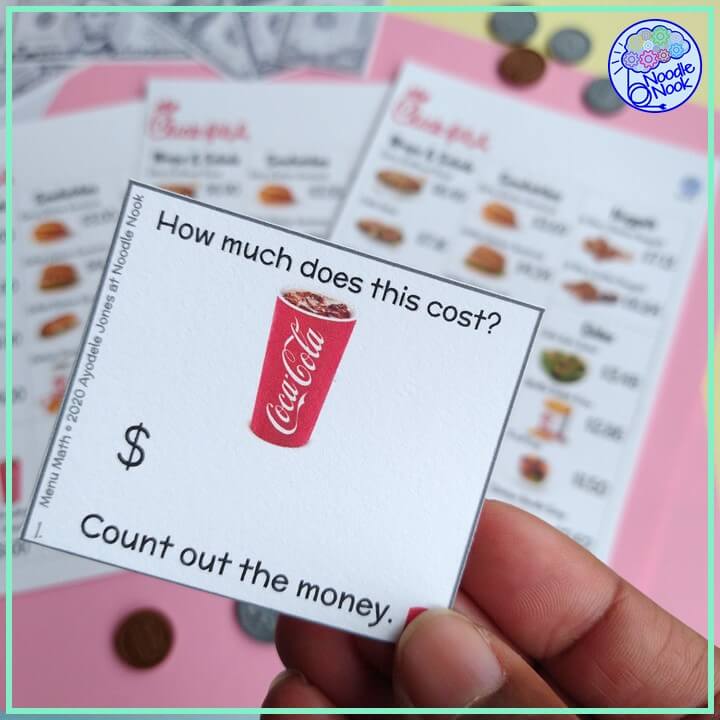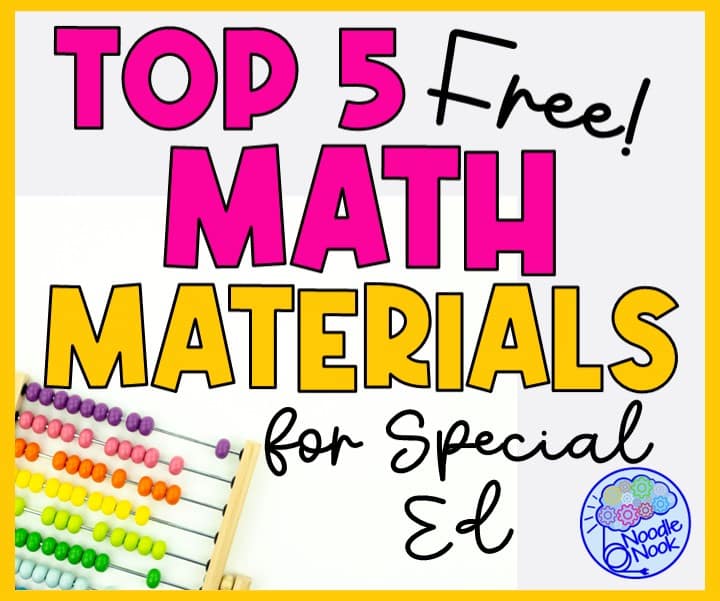Math is one of the most important subjects for students with disabilities. The ability to understand and use math concepts is essential for success in school. It also directly impacts the ability of an individual to be successful in the workplace and in life in postsecondary. That’s why knowing the top 5 math materials for special ed students to use to access the lesson content is critical for your success as a teacher.
When teaching math to students with disabilities, it’s important that the material is tailored to individual needs. It’s also important to have a variety of materials to support students in their math learning.
Adapting or finding the appropriate materials that cater to the unique needs of students with significant disabilities can be a key to success. From hands-on manipulatives to technology tools, the right materials can make math instruction more accessible and engaging.
In this article, we’ll share the top 5 math materials for special ed teachers to use in their instruction to help support students with disabilities to learn.

1. Teach Math Using Pictures and Manipulatives
Incorporating the use of pictures and manipulatives can make math concepts more concrete for students with significant disabilities, it can also make them more engaging. Manipulatives such as counting bears, base ten blocks, or pattern blocks can provide a hands-on approach to learning that can help students better understand and retain math concepts.
How to Teach Math Using Pictures and Manipulatives
It’s easy to get started with manipulatives in your math instruction.
- To teach math concepts using pictures and manipulatives, start by selecting an appropriate math concept and matching manipulatives.
- Next, create a visual representation of the concept, using pictures or symbols.
- Provide hands-on opportunities for students to explore and manipulate the manipulatives while you model how to use them to solve the math problem.
- Monitor student progress and adjust instruction as needed.
Who Benefits from Math Manipulatives?
Manipulatives benefit students in a lot of different ways. Depending on the needs of your students, you may find some manipulatives support students more than others. Consider students with these needs:
- Students with visual impairments or blindness: Manipulatives such as raised-line graph paper or braille manipulatives can help these students to better understand and engage with math concepts.
- Students with cognitive disabilities: Manipulatives can provide a concrete and hands-on way for students with cognitive disabilities to understand and work with math concepts. They can also provide extra support for students who have difficulty with abstract thinking.
- Students with motor impairments: Manipulatives that are specifically designed for students with motor impairments, such as adapted jumbo math manipulatives, can be easier for these students to handle and use.
- Students with autism: Manipulatives can provide a structured and predictable way for students with autism to engage with math concepts, and can also be helpful for those who need a more tactile approach to learning.
- Students with language impairments: Manipulatives can provide a visual and tangible representation of math concepts, which can help students with language impairments to better understand and express themselves mathematically.
2. Use Flashcards and Games
Flashcards and games can be useful tools for teaching and reinforcing math concepts in the special education classroom. Flashcards can be used to teach math vocabulary and concepts, while games can provide a fun and interactive way to practice math skills.
How to Use Flashcards and Games
Using flashcards and games in the classroom is a great way to increase student engagement and also motivation. Those are two things we always want to keep high!
- Start by selecting appropriate math concepts to be covered.
- Create flashcards with math vocabulary or concepts written on them or use pre-made ones.
- Use games that are designed to teach or reinforce specific math concepts.
- Incorporate flashcards and games into daily instruction and provide students with opportunities to use them during independent work time or in small groups.
What Games Work in Math?
There a literally tons of ways to gamify math instruction in your classroom and add math materials for special ed students. Consider these:
- Roll and Cover: Create a game board with different math problems written on it, and have students roll a die or spin a spinner to determine which problem they must solve. Once they solve the problem, they can cover it with a marker. The first student to cover all the problems wins.
- Domino Match: Print math problems on dominoes, then have students match the correct answers to the problems.
- Game Show Mania: Create a game show format with math problem “lightning round” questions, students can use buzzers, or hand signs to answer
- Scavenger Hunt: Create a scavenger hunt with math problems hidden around the room. Students can work in teams or individually to find the problems and solve them.
- Spatial Reasoning: Use tangrams or pattern blocks to create different patterns, students need to replicate them.
- BINGO: Create a math BINGO board with different math problems or math vocabulary written on it. Students can solve the problem or say the vocabulary word to mark it off on their board.
- Memory match: Create a math memory match game, with matching problem and solution cards.
- Card games: Create math card games like “War” or “Go Fish” using math problems or math vocabulary on the cards.
- Board games: Adapt board games like “Chutes and Ladders” or “Snakes and Ladders” to include math problems on the spaces.
- Escape room: Create an escape room with math-based challenges and clues.
All of these activities can provide more fun and engagement during your math lessons or allow you to set up math centers where students work on social skills and communication as well as math.

3. Incorporate digital resources & materials
Technology can provide a wealth of resources and materials to support math instruction for students with significant disabilities. Interactive whiteboards, math-specific software, or math apps can help make math concepts more concrete and accessible.
How to Incorporate Digital Resources and Materials
To incorporate digital resources and materials in the special education math classroom, research and select age- and skill-appropriate technology tools such as interactive whiteboards, math-specific software, or math apps. Learn how to use these tools effectively and incorporate them into your daily instruction. Provide students with hands-on opportunities to interact with the technology and monitor their progress.
Digital Math Materials for Special Ed
Here are some examples of digital resources and materials that can be used to support math instruction in special education classrooms:
- Online math games and interactive activities: Websites such as Math Playground and Funbrain offer a wide variety of interactive math games and activities that can be used to teach and reinforce math concepts in a fun and engaging way.
- Math-specific software: Programs such as Math-U-See, DreamBox, and IXL Math offer interactive math instruction, practice, and assessments that can be tailored to the student’s level and skill.
- Math apps: There are a wide variety of math apps available for smartphones and tablets that can be used to teach and reinforce math concepts. Examples include Math Learning Games, Prodigy Math Games, and Math Wizard.
- Interactive whiteboards: Interactive whiteboards such as Smartboard or Promethean Board, allow teachers to present and work on math problems and also provide opportunities for students to interact and engage with the material.
- Online math tutorials and videos: Websites such as Khan Academy and LearnZillion offer a wide variety of online math tutorials and videos that can be used to teach and reinforce math concepts.
- Virtual manipulatives: Some websites and apps like National Library of Virtual Manipulatives offer interactive, digital manipulatives, that can be used to explore and understand math concepts
- Calculators: Yes, fancy calculators like the TI-84 or TI-Nspire, can be used to perform advanced calculations, but our students can benefit from a better understanding of the tech in their pocket. Practice with cell phone apps and speech-based calculators, like Alexa!
- Adaptive Learning Platforms: some platforms like ALEKS, or Zearn can adapt the math instruction according to the student’s needs, and provide additional support, to personalize the learning.
These resources and materials can help make math instruction more engaging and interactive for students with significant disabilities. They can also provide additional support to help them understand and retain math concepts. Keep in mind that, as with any tool, it’s important to evaluate whether it fits your specific students’ needs and tailor the use accordingly.
4. Go Beyond Worksheets with Hands-On Activities
Hands-on activities can provide a more engaging and interactive way to teach math concepts and skills, especially for students with significant disabilities. These activities can supplement or replace traditional worksheets in the special education classroom. Believe me when I tell you that this is the best of the top 5 math materials for special ed.
How to Go beyond worksheets with hands-on activities
To go beyond worksheets with hands-on activities, research and select activities that are appropriate for the math concepts you will be teaching. Incorporate hands-on activities into your daily instruction, such as using manipulatives, creating visual representations, or real-life examples.
Provide students with opportunities to explore and experiment with the materials while you model the math problem and guide their thinking. Allow time for independent practice, and incorporate reflection and self-evaluation into the activity.
What Non-Worksheet Math Materials Work Best?
Here are some examples of real-world math problems that can be used to teach and reinforce independent living skills for students with disabilities:
- Budgeting: Have students create a budget for a fictional month, considering expenses such as rent, groceries, transportation, and entertainment. They can then practice keeping track of their expenses throughout the month and making adjustments to their budget as needed.
- Time management: Have students plan and schedule a daily routine, including tasks such as getting ready for the day, going to school or work, and leisure activities. They can practice keeping track of their time and making adjustments to their schedule as needed.
- Meal planning and shopping: Have students plan and prepare a simple meal, create a shopping list of the necessary ingredients and use math to budget the cost.
- Measurement and Cooking: Have students follow a recipe, using measurement conversions and ratios to adjust the serving size.
- Basic money skills: Have students practice counting money, making change, and calculating prices including taxes and discounts. READ THIS FOR MORE!
- Personal hygiene: Have students create a daily hygiene routine, including tasks such as brushing their teeth, showering, and dressing. They can practice timing these tasks and adjusting their routine as needed.
- Transportation: Have students plan a public transportation route, including transfers and fare calculation. They can also use map skills to plan a walking or biking route.
- Health and fitness: Have students create a fitness plan, including goals, tracking progress, and making adjustments as needed
By solving real-world math problems that are related to independent living skills, students can learn and practice math concepts in a meaningful and practical way that can help them become more self-sufficient and independent.
5. Provide Extra Support with Graphic Organizers
Graphic organizers are definitely a part of the top 5 math materials for special ed. They can provide extra support for students with significant disabilities as they work through math problems. Organizers such as number lines, hundred charts, or number grids can provide a visual representation of math concepts that can help students better understand and retain math concepts. Using graphic organizers can also help students to better organize their thinking, and guide their problem-solving strategies.
How to Provide extra support with graphic organizers
Graphic organizers are an excellent way to support learners in special education. That includes things like those mentioned above as well as task strips, sequence charts, and calculator cheat sheets that all support a student to perform a skill, not just learn it. With all these graphic organizers, follow this format:
- Start by selecting appropriate math concepts to be covered.
- Create or select graphic organizers that align with the math concepts.
- Introduce the graphic organizers during instruction.
- Modeling how to use them to solve math problems and organize thinking.
- Provide opportunities for independent practice.
- Incorporate reflection and self-evaluation into the activity.
- Continuously monitor student progress and adjust instruction as needed.
Recap: Top 5 Math Materials for Special Ed.
If you’re looking to add items to your math instruction to get more traction with students, especially students with special needs, try these:
- Pictures and Manipulatives
- Flashcards and Games
- Digital Resources
- Go Beyond Worksheets
- Graphic Organizers
Some students require unique and targeted resources to support math instruction. These top 5 math materials for special ed can be used to make math concepts more concrete and accessible for students with significant disabilities. From manipulatives to graphic organizers and digital resources, these materials will take your special education math instruction to the next level!


